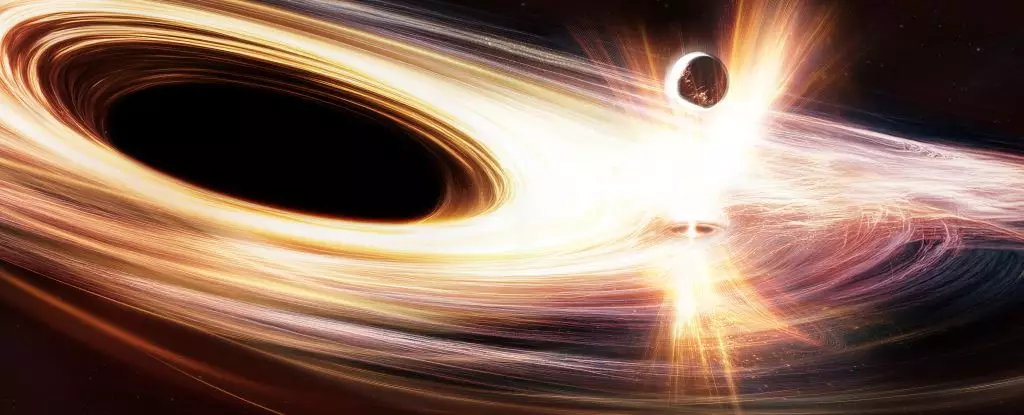Astrophysics is a field rife with enigmas, but few phenomena capture the imagination quite like the mysterious behaviors of supermassive black holes. At the very heart of this intrigue lies Ansky, a supermassive black hole located approximately 300 million light-years from Earth in the galaxy SDSS1335+0728. Since 2019, its behavior has puzzled experts, as it transitioned from a dormant state to an astonishingly active phase characterized by excessive bursts of light and energy. Unlike typical black hole activities observed in the universe, Ansky’s eruptions flaunt longer durations and higher luminosities that defy established theories. This surprising behavior raises profound questions about our existing frameworks for understanding such celestial entities and hints at a dynamic model of black hole activity that is far more complex than previously imagined.
The Extraordinary Eruptions of Ansky
Research led by astrophysicist Joheen Chakraborty at MIT reveals that Ansky’s X-ray outbursts are up to ten times longer and more intense than those emitted during typical quasi-periodic eruptions. Remarkably, the energy released during Ansky’s events is reported to be a staggering hundred times greater than what has been recorded in other supermassive black holes. With burst frequencies measured at an astonishing 4.5 days, researchers are grappling to adapt existing models to explain this black hole’s unusual behavior. Each discovery seems to provoke more questions, as it sheds light on the ongoing debate surrounding black hole dynamics and their influence on galactic evolution.
Understanding the Quiescent State
The common perception of black holes often portrays them as inexorable cosmic vacuums, continually drawing in and devouring everything in their vicinity. While this imagery holds some truth, it drastically oversimplifies the behavior and lifecycle of these dense gravitational giants. Supermassive black holes can oscillate between active and dormant states, the latter characterized by periods of low accretion activity. Astronomers have long accepted that black holes such as the one at the heart of our Milky Way exhibit minimal activity. These periods of quiescence raise a crucial point about how black holes evolve alongside their host galaxies. Notably, as black holes undergo active phases, they contribute significantly to the star formation and chemical evolution of their galaxies, suggesting a vital interplay between these massive objects and their cosmic environments.
Ansky’s Unique Patterns
Ansky’s eruptions challenge the prevailing theories about black hole activity. Historically, astrophysicists have posited that quasi-periodic eruptions are triggered when an object—be it a star or a smaller black hole—ventures too close to a supermassive black hole, becoming ensnared in accretion flows that lead to periodic emissions of energy. However, the light from Ansky presents a perplexing case. Its radiant emissions span a broad spectrum of wavelengths, from infrared to X-rays, and last significantly longer than predicted for interactions with cosmic objects. This indicates that the forces at play within Ansky’s gravitational well are not completely understood and may require the development of new theories to accurately explain the phenomena.
The Implications for Future Research
The discoveries surrounding Ansky do more than provoke curiosity; they stand to reshape our understanding of how black holes function within the universe. As Lorena Hernández-García, the lead astronomer from Chile’s Millennium Institute of Astrophysics, emphasizes, the observations of Ansky represent a groundbreaking opportunity to delve deeper into black hole evolution. Unraveling the mystery of Ansky’s behavior could significantly enhance our grasp of supermassive black holes and their relationship with galaxies on both large and small scales. The data derived from ongoing observations could prove essential in re-evaluating the criteria we use to categorize black hole activities and their implications for cosmic evolution.
A Glimpse Into the Future of Astrophysics
As we stand on the precipice of astronomical breakthroughs enabled by advanced technologies and upcoming missions, such as ESA’s LISA, the promise of further understanding black holes grows brighter. The potential for detecting gravitational waves associated with phenomena like Ansky’s eruptions opens up a new frontier in astrophysical research. As humanity seeks to demystify the intricacies of the universe, Ansky may well be a pivotal point of focus, challenging established paradigms and inspiring innovative approaches to our exploration of the cosmos. The journey into understanding these enigmatic forces will yield indispensable insights into not only black holes but also the very fabric of our universe.

